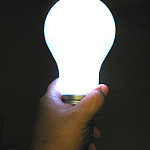

Photo by frankieleon licensed under CC BY 2.0
Street lights may never be the same again. Even the name has changed … they are now called “smart lights.”
Smart lights have two mechanisms – luminaries, the technology that creates illumination, and a control or communication component. Luminaries include fluorescent bulbs, high-intensity discharge (HID) lamps and light-emitting diode (LED) bulbs. The control and communication components are responsible for intelligence, and this technology relies on sensors, microcontrollers and receivers.
More than half of the world currently lives in a metropolitan area, and that number is expected to grow to 60 percent by 2030. The population increase is creating all kinds of concerns such as traffic congestion, safety, infrastructure strain, spiraling costs, energy consumption and service capacity. Smart lights offer relief in areas such as cost reduction, data collection and optimization of city operations.
San Diego was the first U.S. city to pilot an intelligent lighting program in 2014. With auditory sensors, vibration sensors and visual sensors, LED lights now extract data that the city pulls into a cloud-based platform that allows real-time analysis. The analysis provided helps city planners to be more efficient in planning for parking. Ultimately, software developers could use the data to develop a parking app that helps guide drivers to empty parking spaces and pay for the parking spot through the app.
LED lights have an incredibly long lifetime, they don’t produce infrared or UV emissions and have an efficient energy release. The attached sensors allow more accurate energy metering, which allows cities to only pay for the energy they actually use. To date, the lights have saved San Diego $250,000 annually.
Besides the cost savings, there are many other benefits from smart lights. In Texas, Round Rock is among the first cities to pilot a smart lighting trial used for security and emergency services. A pilot program was established with 100 smart lights and now it is possible to control stop lights from a central location.
For example, while in route to an emergency situation, a fire truck can remotely activate the system to have street lights flash red ahead of the truck’s route. This informs drivers that an emergency vehicle is approaching and it reduces travel times for the emergency vehicle.
Cities have not been the only entities to utilize smart lights. In 2012, the University of California, Davis (UC Davis) installed a smart light system that uses motion sensor equipment to provide alerts when pedestrians or bicycles are approaching. The lights also predict the direction travelers are heading and light the path ahead.
UC Davis also partnered with NorthBay VacaValley Hospital in Vacaville to implement smart lights that illuminate emergency vehicle routes, parking lots and walkways. The smart lights have been well received by hospital doctors and nurses, and the smart lights have reduced the hospital’s outdoor lighting energy use by 66 percent.
Most recently, the city of Los Angeles formed a public-private partnership (P3) with two private companies to install a “smart lighting” system that will combine street lights and cell towers. The companies – one a lighting manufacturer, the other a telecommunications technology firm – will install 100 smart poles that will feature energy-efficient LED lights and 4G LTE wireless service.
The smart lighting market is predicted to grow to $8.14 billion by 2020. The trend to smart lights is gathering traction quickly.
